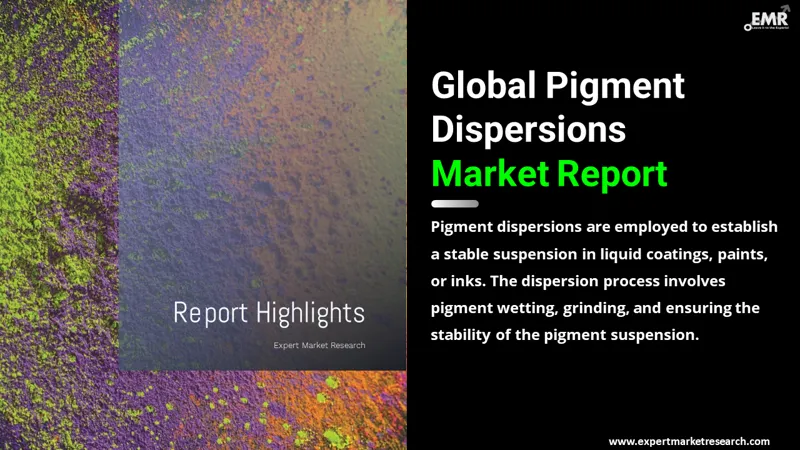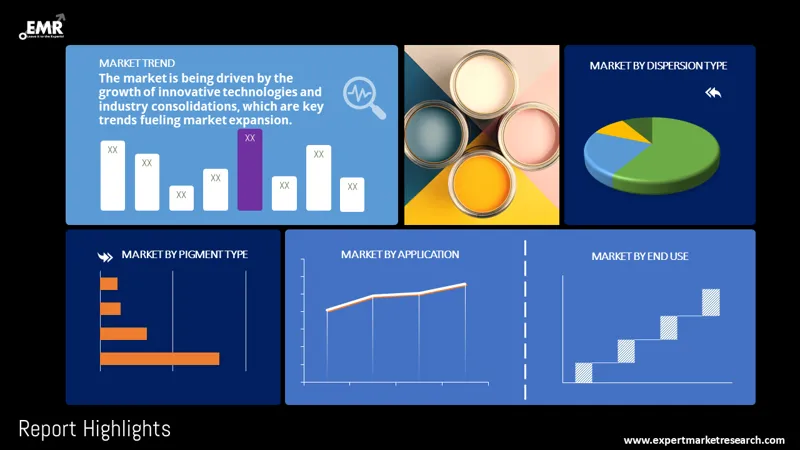
Consumer Insights
Uncover trends and behaviors shaping consumer choices today
Procurement Insights
Optimize your sourcing strategy with key market data
Industry Stats
Stay ahead with the latest trends and market analysis.
The global pigment dispersions market size stood at USD 53.91 Billion in 2025 and is projected to reach USD 88.65 Billion by 2035, growing at a CAGR of 5.10% between 2026 and 2035.
Base Year
Historical Period
Forecast Period
Compound Annual Growth Rate
5.1%
Value in USD Billion
2026-2035
*this image is indicative*
The growing pigment dispersions market for pigment dispersions in the Asia Pacific, like India, China, and Australia, is expected to be driven by the growing construction industry in the region.

Read more about this report - REQUEST FREE SAMPLE COPY IN PDF
Pigment Dispersions are used to create a stable suspension for liquid coatings, paints, or inks. The method of dispersion is pigment wetting, grinding phase, and pigment suspension stability. Pigment dispersion is the method in which pigment powder is broken down by mechanical shear in individual particles so that after this phase, the pigment agglomerates are broken back together to form larger structures.
The pigment dispersions market can be divided based on segments like dispersion type, pigment type, application, and end-use.
Market Breakup by Dispersion Type
Market Breakup by Pigment Type
Market Breakup by Application
Market Breakup by End Use
Market Breakup by Region

Read more about this report - REQUEST FREE SAMPLE COPY IN PDF
The increasing demand in the building and construction sector for paints and coatings is driving the pigment dispersions market growth. Pigment dispersion based on water is commonly used in significant applications such as paints and coatings and inks for printing and plastics. The building and construction segment was the largest consumer of pigment dispersions in 2020, whereas, during the forecast period, the automotive sector is expected to be the fastest-growing end-use sector. Due to its low VOC, excellent gloss, elevated tinting strength, fluidity, and storage stability characteristics, water-based dispersion is the more prominent and faster-growing dispersion form. The development of the market for pigment dispersions in the Asia Pacific is driven primarily by the strong demand in the construction and manufacturing sector. The growing population and increasing end-use sectors have resulted in innovation and growth, making the Asia Pacific a major industrial hub worldwide. It is anticipated that high growth and innovation, together with sector consolidations, will lead to the fast growth of the market in the region. Pigment dispersions are also essential for the manufacturing of various cosmetics products; thus, the growth of the cosmetics industry is also expected to drive the pigment dispersions market growth. However, owing to its damaging impact on health and environment, strict restrictions on the manufacturing of pigments are a significant constraint to the pigment dispersions market growth.
The report presents a detailed analysis of the following key players in the global pigment dispersions market, looking into their capacity, market shares, and latest developments like capacity expansions, plant turnarounds, and mergers and acquisitions:
The EMR report gives an in-depth insight into the industry by providing a SWOT analysis as well as an analysis of Porter’s Five Forces model.




*While we strive to always give you current and accurate information, the numbers depicted on the website are indicative and may differ from the actual numbers in the main report. At Expert Market Research, we aim to bring you the latest insights and trends in the market. Using our analyses and forecasts, stakeholders can understand the market dynamics, navigate challenges, and capitalize on opportunities to make data-driven strategic decisions.*
Get in touch with us for a customized solution tailored to your unique requirements and save upto 35%!
In 2025, the global pigment dispersions market attained a value of nearly USD 53.91 Billion.
The market is projected to grow at a CAGR of 5.10% between 2026 and 2035.
The market is estimated to witness a healthy growth in the forecast period of 2026-2035 to reach USD 88.65 Billion by 2035.
The major drivers of the market include rising urbanisation, increasing demand in the building and construction sector for paints and coatings, rising population, and growing demand from end-use sectors.
Growing innovation and sector consolidations are the key market trends propelling the growth of the market.
The major regions in the market are North America, Latin America, the Middle East and Africa, Europe, and the Asia Pacific.
Water-based dispersions has been the dominant segment in the market
Based on pigment type, the market is bifurcated into organic pigments and inorganic pigments. Organic pigments are further subdivided into azo pigments, phthalocyanine pigments, and high performance pigments, among others, while inorganic pigments are divided into titanium dioxide, iron oxide, and carbon black, among others.
The diverse applications in the market are paints and coatings, inks, and plastics, among others. Paints and coatings applications are subdivided by type into automotive coatings, decorative coatings, and industrial coatings.
The end use segments are building and construction, automotive, packaging, paper and printing, and textile, among others.
The major players in the market are DIC Corporation, Clariant AG, BASF SE, Chromaflo Technologies Corporation, Cabot Corporation, Heubach GmbH, Penn Color, Inc., and Pidilite Industries Ltd, among others.
Explore our key highlights of the report and gain a concise overview of key findings, trends, and actionable insights that will empower your strategic decisions.
| REPORT FEATURES | DETAILS |
| Base Year | 2025 |
| Historical Period | 2019-2025 |
| Forecast Period | 2026-2035 |
| Scope of the Report |
Historical and Forecast Trends, Industry Drivers and Constraints, Historical and Forecast Market Analysis by Segment:
|
| Breakup by Dispersion Type |
|
| Breakup by Pigment Type |
|
| Breakup by Application |
|
| Breakup by End Use |
|
| Breakup by Region |
|
| Market Dynamics |
|
| Competitive Landscape |
|
| Companies Covered |
|
| Report Price and Purchase Option | Explore our purchase options that are best suited to your resources and industry needs. |
| Delivery Format | Delivered as an attached PDF and Excel through email, with an option of receiving an editable PPT, according to the purchase option. |
Datasheet
One User
USD 2,499
USD 2,249
tax inclusive*
Single User License
One User
USD 3,999
USD 3,599
tax inclusive*
Five User License
Five User
USD 4,999
USD 4,249
tax inclusive*
Corporate License
Unlimited Users
USD 5,999
USD 5,099
tax inclusive*
*Please note that the prices mentioned below are starting prices for each bundle type. Kindly contact our team for further details.*
Flash Bundle
Small Business Bundle
Growth Bundle
Enterprise Bundle
*Please note that the prices mentioned below are starting prices for each bundle type. Kindly contact our team for further details.*
Flash Bundle
Number of Reports: 3
20%
tax inclusive*
Small Business Bundle
Number of Reports: 5
25%
tax inclusive*
Growth Bundle
Number of Reports: 8
30%
tax inclusive*
Enterprise Bundle
Number of Reports: 10
35%
tax inclusive*
How To Order

Select License Type
Choose the right license for your needs and access rights.

Click on ‘Buy Now’
Add the report to your cart with one click and proceed to register.

Select Mode of Payment
Choose a payment option for a secure checkout. You will be redirected accordingly.
Gain insights to stay ahead and seize opportunities.

Get insights & trends for a competitive edge.

Track prices with detailed trend reports.

Analyse trade data for supply chain insights.

Leverage cost reports for smart savings

Enhance supply chain with partnerships.

Connect For More Information
Our expert team of analysts will offer full support and resolve any queries regarding the report, before and after the purchase.
Our expert team of analysts will offer full support and resolve any queries regarding the report, before and after the purchase.
We employ meticulous research methods, blending advanced analytics and expert insights to deliver accurate, actionable industry intelligence, staying ahead of competitors.
Our skilled analysts offer unparalleled competitive advantage with detailed insights on current and emerging markets, ensuring your strategic edge.
We offer an in-depth yet simplified presentation of industry insights and analysis to meet your specific requirements effectively.
Share